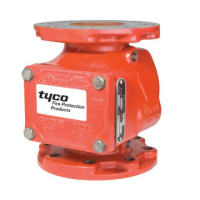TFP910
Page 5 of 22
Design
Criteria
In planning installation of the Tyco
®
Model AV-1-300 Alarm Check Valves,
consideration must be given to the
disposal of the large quantities of wa-
ter that may be associated with drain-
ing the system or performing a flow
test.
Valves installed in the vertical position
must have the flow going up. Valves
installed in the horizontal position
must be positioned so that the drain
connection points down.
The sprinkler system designer must
be aware that the configuration of the
pip ing network and its tendency to
trap pockets of air (such as in the case
of a peaked-roof gridded system) can
af fect the performance of the alarm
sys tem. Although a slight amount
of trapped air is desirable to prevent
significant pressure increases due to
thermally induced expansion of the
water, a large quantity of trapped air in
a system may result in the possibility
of an intermittent alarm.
The possibility of an intermittent alarm
condition is a consequence of the fact
that the flow out of the system through
the test valve or a single sprinkler is
very small relative to the flow that can
be passed through the valve. This dif-
ference increases with valve size. If the
system were free of trapped air, flow in
would equal flow out and the Water-
way Clapper would always stabilize at
some open position (as needed to ac-
commodate the required flow). With
trapped air in the system, however,
the Waterway Clapper first opens wid-
er since the system initially demands
greater flow until the air pockets are
compressed (back to nearly the sup-
ply pressure), and then it will tend to
return closer to the Seat Ring. If the
volume of the air pockets is excessive,
flow into the sys tem can be momen-
tarily reduced to nearly zero (once the
air pockets are compressed) and the
Waterway Clapper may close, causing
flow to the alarms to be shutoff.
After the Waterway Clapper has
closed, sufficient water must flow out
of the system before the Waterway
Clapper will again open. A repetition
of the above described condition is
termed an intermittent alarm.
Using a vent (which can also serve
as an end-of-line Inspector’s Test
Connection) piped from the top of a
cross main or end of a branch line at
the point most remote from the alarm
valve, and filling the system slowly in
accordance with the steps described
in the Setting Procedure section, can
prevent an excessive amount of air
from being trapped.
Installation
NOTICE
Proper operation of the Tyco
®
Mod-
el AV-1-300 Alarm Check Valves de-
pends upon the trim described in this
data sheet installed in accordance
with the following instructions. Failure
to follow the appropriate trim installa-
tion instructions may prevent the de-
vice from functioning properly as well
as void listings/approvals and the
manufacturer’s warranties.
The Alarm Check Valves must be in-
stalled in readily visible and accessible
locations.
It is recommended that provision be
made for viewing the alarm line drain
water by locating the main drain outlet
in a readily visible area.
Wet pipe fire protection systems must
be maintained at a minimum tempera-
ture of 40°F/4°C.
Step 1. Trim the Alarm Check Valve in
accordance with Figure 4, 5, or 6, as
applicable. Apply pipe-thread sealant
sparingly to male threads only.
Step 2. The Alarm Vent Trim illustrated
in Figure 8 must be installed if a water
motor alarm is not to be used.
Step 3.
Plug unused alarm connec-
tions.
Step 4. Suitable provision must be
made for disposal of alarm line and
system drainage water. Drainage wa-
ter must be directed so that it will not
cause damage or result in danger ous
conditions.
Step 5. The alarm line drain must be
arranged so that there will be no dan-
ger of freezing.
Step 6.
The check valve in the exter-
nally mounted bypass around the Wa-
terway Clapper must be installed with
its arrow pointed up, and the drain
check valve must be installed with its
arrow pointing towards the drain.
Step 7. It is recommended that a vent
connection (which may also be used
as an end-of-line Inspector’s Test
Connection), be piped from a cross
main or branch line at the point most
remote from the alarm valve. The vent
line should be connected to the top of
a cross main or to the end of a branch
line and be located at the highest level
of a multi-level installation.
The vent connection can be used
to bleed-off excessive air from the
system, and therefore, minimize the
possibility of a false alarm due to a
transient surge in supply pressure.
The contraction/expansion associated
with an excessive amount of trapped
air could also cause the Waterway
Clapper to cycle open and shut
during an inspector’s test or during a
discharge by a single sprinkler.

